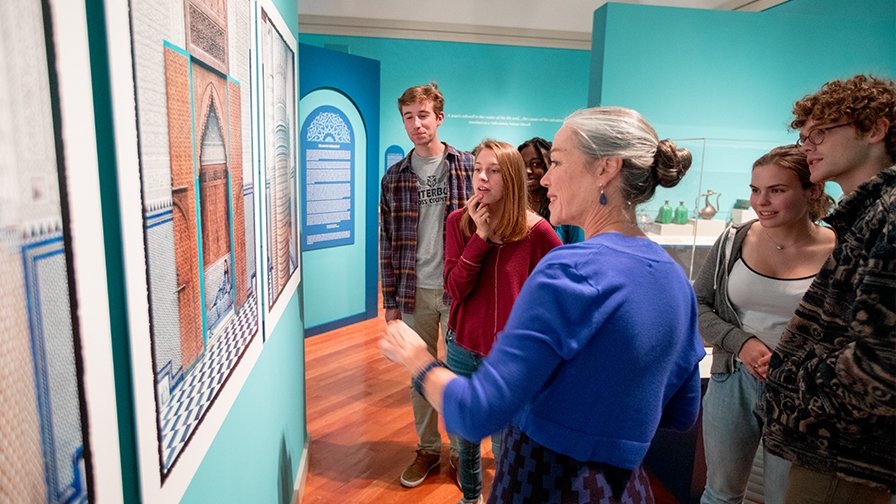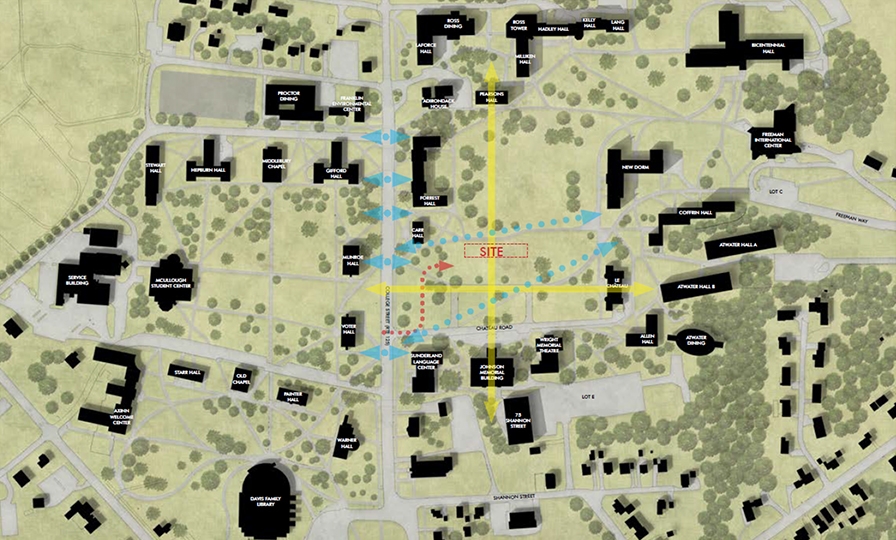A New Museum for Middlebury
A New Museum for Middlebury

Creating a Campus Hub for the Arts
A teaching museum is integral to a liberal arts education. The Middlebury College Museum of Art connects our collection with students across disciplines in order to engage them in a deeper understanding of a culture, a country, a period of time.
Today, Middlebury has an opportunity to expand the Museum of Art’s reach and impact through a new building and a new location. With expansive study, gallery, and gathering spaces, the new museum will engage students and faculty from every discipline, stimulating discussion and new ways of seeing the world. Situated near the current site of Battell Hall and across from Johnson Memorial Building and Wright Theatre, the museum will create a campus hub for the arts.
The plan for a new museum has been met with an enthusiastic response. To date, Middlebury has raised more than half of the $50 million anticipated cost. To avoid incurring any new debt, the College seeks to raise the remaining funds from alumni, parents, and friends. This project provides donors with an opportunity to bring the arts to the center of campus, transforming how we use it.
WORKING TIMELINE
- 2020 Site selected northwest of the Château for a new first-year residence hall to replace Battell Hall
- 2021 Discussions begun about locating a museum on the Battell Hall site, creating an arts quadrangle on the north side of campus
- 2022 Planning study for new museum undertaken
- 2023 Renovation of Johnson Memorial Building completed
- 2024 Planning for new museum underway
- 2024 Architect selection
- 2026 Expected demolition of Battell Hall
- 2026 Expected museum construction start date
- 2028 Expected completion date
BY THE NUMBERS
$50 MILLION Cost to construct the new museum
35,000 Gross square footage of the new museum
7,000 Objects in the collection
26 Academic departments actively using the museum

MEETING CHANGING NEEDS
In the three decades since the Museum of Art opened, how we engage with art has changed. There is increased interest in primary sources and in what art and artifacts can teach us. How does a work of art’s meaning change when seen through the lens of chemistry or math as compared to art history? How do different backgrounds and perspectives add to the story of our collection and make new knowledge possible?
While access to the museum and its collection might once have been limited to the Departments of History of Art and Architecture and Studio Art, in the 21st century students and faculty across all disciplines seek access to the museum to further their knowledge, explore primary sources, and validate or refute assumptions.
A new museum will become a laboratory serving the entire academic program, giving students and faculty more teaching and learning spaces and providing more gallery space for the extensive collection.
A LEARNING LABORATORY
The new museum will make the nearly 7,000 works in Middlebury’s collection readily accessible for study and teaching. Currently, only a small fraction of our collection can be on view at any given moment, which means a large number of objects are rarely seen. Our collection storage spaces are full, and it is difficult to move an object from storage if a faculty member wants to share it with a class.
That will all change when the new museum opens. The gallery space will nearly double, and objects in the collection will become more accessible. The variety of spaces will allow us to explore innovative ways to access and examine our collection, which includes art and objects from around the world from the fourth millennium B.C.E. to the present. The collection of 20th-century and contemporary art encompasses works in all mediums, with particular strength in prints and photographs. Galleries and teaching spaces will be designed to be inviting and to encourage discovery, close looking, and engaging discussion.
The new museum will have all the other features of an exemplary academic museum of art—teaching spaces, dedicated research areas, on-site storage—as well as open and flexible spaces designed for multidisciplinary learning, performances, and exhibitions that will support teaching, learning, and community building.
Most importantly, the museum will be designed for object study. Object study deeply immerses the student in the artist’s creative process. To rotate and examine an ancient Greek vase under magnification and enhanced lighting conditions, for example, can transport the viewer, providing a deeper understanding of the artistic methods, the conditions, and the people of that period. Such object study is essential to a liberal arts education; it allows the viewer to draw on the politics of the time, the cultural moment, the religious beliefs, and the chemistry and science of the medium.
PURPOSE-BUILT FOR THE VISUAL ARTS
This will be Middlebury’s first purpose-built museum building. Its construction at the heart of campus will elevate the visual arts as a key institutional priority.
The Johnson Memorial Building—completed in 1968—included the first dedicated art gallery on campus, but the building’s main use was as an interdisciplinary center for the Studio Art and Music Departments and a place in which artistic collaboration would naturally percolate. The current museum is part of a larger arts complex designed by Hardy Holzman Pfeiffer Associates and completed in 1992 as a venue for art exhibition and performance—including a surround concert hall, a studio theater, and a dance performance space. Relocating the museum to a new building will create additional space in the Mahaney Arts Center for dance, theater, and music, allowing Middlebury to meet the growing demand for rehearsal and performance venues.
In the decades since the arts center opened, the museum collection and its engagement with the local and regional community have expanded significantly. Today, Middlebury’s museum is one of Vermont’s premier visual arts venues, one of only 3 percent of museums nationwide that are accredited by the American Alliance of Museums. Each year, the museum mounts significant exhibits, including some in partnership with the Hood Museum at Dartmouth, Shelburne Museum, Art Museum of the Americas, and other institutions.
EDUCATING LEADERS IN THE ART WORLD
The museum also provides immersive-learning opportunities for College students interested in careers in the arts. Many students from across the curriculum have participated in the Museum Ambassadors Program or worked as interns or receptionists at the museum. The museum provides field experience across the spectrum of museum positions: curatorial, engagement, design, publicity, administration, and visitor services.
Many of these students have gone on to become leaders at national museums, including the Chicago Art Institute, Whitney Museum of American Art, and High Museum; other arts organizations, such as Sotheby’s; and prominent galleries.
THE IMPACT
- The new museum will make the nearly 7,000 works in Middlebury’s collection accessible for study, teaching, and research. It will create the largest classroom on campus, inviting study and inquiry from departments across the disciplines and expanding the ways that students, faculty, and visitors engage with art.
- It will nearly triple the size of the existing museum, nearly doubling gallery space, while offering teaching spaces, object-study space, dedicated research space, ample on-site storage, and open and flexible spaces designed for multidisciplinary learning, performances, and exhibitions inside and outside the museum.
- Currently, 26 academic departments rely on the museum to inform and support their teaching. The new museum will create opportunities for many more faculty members to take advantage of the collection in their teaching and research.
- The new building will reflect Middlebury’s commitment to sustainable and accessible design, materials, patterns of use, and connection to the natural and built environment.
- Building a dedicated museum in a central location across from Johnson Memorial Building and Wright Theatre will make the visual arts more accessible to students and faculty from across campus.
- The museum plays an important role in the local and regional community in expanding access to the arts. More than 10,000 people visit the museum each year. Gallery talks, lectures, panel discussions, demonstrations, public art walking tours, and artist Q&A sessions provide opportunities to explore and engage the collection and exhibitions.
- The staff work with local schools to engage children in the visual arts, enabling teachers to contextualize collections within the scope of their curriculum and to help them meet state academic standards.


THE ARTS AS CATALYST
The construction of a new first-year residence hall that will replace Battell Hall is now underway northwest of Battell with completion expected in summer 2025. With the planned demolition of Battell Hall in 2026, an exceptional site at the heart of the campus will become available in proximity to Johnson Memorial Building—the home of studio arts and the architecture program.
Trustees and campus leaders had long discussed the need for a new museum and for a student gathering space. A planning study in 2022 determined both could be met by locating a new museum on the Battell site. There it will join the recently renovated Johnson Memorial Building, Wright Memorial Theatre, le Château, and Sunderland Language Center, with its popular Dana Auditorium, to create a new campus quadrangle on the north side of Route 125.
The quad will support outdoor exhibits, musical events, sculptural installations, and theatrical performances—creating what President Laurie Patton describes as “an arts agora.” The agora, or open place for assembly, was the center of ancient Greek public life, a hub for politics, commerce, philosophy, art, and religion. This new building and quadrangle will draw students, faculty, staff, and the community together in celebration of the arts. It will provide space for conversation, discussion, and disagreement, allowing our students to encounter, debate, and celebrate different viewpoints.
When the museum is completed, people will come to look at art from around the globe and to think deeply about the circumstances in which it was created, how the artists see the world, and what those insights might mean for humanity. In doing so, it will, as President Patton notes, foster stronger citizenship among its local, college, and global communities.
